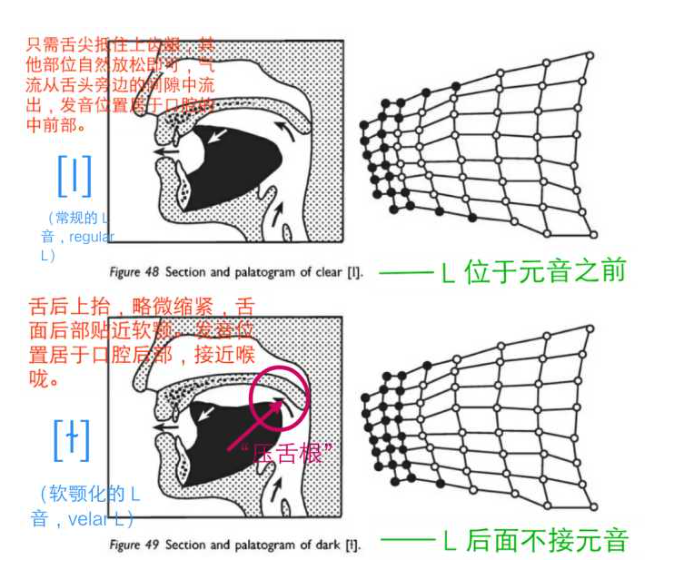跟Paul大叔学美语
前言
本篇文章是对Paul大爷教美语视频的笔记,Paul大爷的视频比较通俗易懂,在部分音,比如L音的教学上比其他视频要明确很多。本文记录视频中的一些要点,规则等,便于日后复习使用。也供人参考,如有错误之处,还望指正。附B站视频链接。
概念
训练脸部的肌肉,相对于中文,以一种新的方式发音,更夸张的面部表情。发音由慢到快,逐渐养成新习惯,摆脱母语发音方式的影响。
5 Vowel - A E I O U
15 Vowel Sounds - some vowels have as many as ten different spellings.
Consonant Sounds - b ch s t f g sh w etc.
Voiced Sound voicing- vocal chords are vibrating, producing a sound. Like AH, OH, OO, A, EE. All vowel are voiced and some consonant are voiced others not.
Unvoiced Sound consonant pair unvoiced and voiced like /p//b/, /t//d/ , /f//v/,/s//z/
辅音
R&W&Q
R发音口型和舌头位置
1) Mouth and lips come tightly forward. 2) Tongue Moves Back
R在词尾或者在元音字母后面,需要收缩回归到R的口型并发出R声。
R Blends: Your lips come forward before you even say the word.
发音混合式,例如发Grape音时候,需要提前形成R的嘴形。
W发音跟R的第一点一样,以发OO(wu)音的嘴型起始。所以在一个单元里比较。
Q发音由KW组合而成,如quick发音为kwuick。不是Q的单词choir的ch也是发kw音。
S&Z
S在单词尾部发音规律的三种情况
- If the last sound in a word is unvoiced, and you are adding an S, then, the S is unvoiced too.
- If a word ends with one of these sounds s(busess),z,sh(pushes),ch,dg(pages) add IZZZZ.
- If a word ends with a vowel sound, add a voiced Z. (Author’s supplement: Ends with other voiced sound ** also voiced **Z)
以上原文给出的规律,1)即词尾字母不发声,发S音。 2)词尾字母发声,发Z音。3)特殊情况发IZ音,见上文。
一些常见的S结尾却发Z的单词, is,his,as,these,those,easy,because
Th&T
Th有voiced[ð]音,如that, they, there, this, those 和unvoiced[θ]音,如thanks, thick, thunder, thursday, think。
舌头露出牙齿外面,如图。在训练时相对夸张的伸出,实际应用中包括老师在内也没有那么明显。

Th在单词中时,需要伸出舌头,产生声带震动,发出[ð]音。如clothing, leather, mother.
Th在词尾发[ð]音的如smooth, bathe,发[θ]音如tablecloth。Breathe做名词时th是[θ]音,作动词是[ð]音。
THR Blends th和r组合时,同样需要着重突入r的音。
例外Th发t的音,如thomas, thompson, thailand, esthter, thyme.
T美语发音很大不同的一点,如果t在元音之间,则发/d/ 音。如water发wader,better发bedder。
F&V&SH
一个常见的发音错误是of发音,应该发ov音.
Gh, ph发f音,如laugh, telephone, symphony, rough.
S发sh/ʃ/音,如she, sugar, sure. Ch发sh音,如chef, Chicago.
单词中发/ʃ/音,nation, special, official, machine, sunshine, insurance, ocean, tissue.
单词中发音/ʒ/音,如usual, casual, Asia, prestige, massage, beige.
L
发音要点,如果已经有错误的L发音习惯,在学习过程中最好忘掉错误的发音和中式的发音。将L当全新的音去练习和理解。
- Mouth should be wide open and jaw should be down.
- Your tongue should rise up and push behind your top teeth.
- Drop and relax your tongue.
L在词尾的发音与开头有细微的差别。图中可以看出来,L在词尾发音会有抬舌根的区别,这个细微的差别在看口型和听声音上不易区别,所以L对于国人也是相对比较难学的一个音。详细可以参考知乎的这篇回答。

FL blend,发f音后快速将舌头置于上齿后,并发L音。
T, D & B, P
本节主要针对部分语系下t,d,b,p等在单词尾部不发音,或者清辅音和浊辅音搞混的情况。在中文语言体系下,不易发生。
针对过去时加ed的情况,发t或者d的规则。规则跟s和z类似,可重温相关部分。
- If a word ends in an unvoiced consonant, add an unvoiced T.
- If a word ends in a voiced consonant, add a voiced D.
- If a word ends in a T or D, add ID.
针对规则3,比如Heat过去时heated,t同时在两个元音之间,参考前文t&d部分。所以heated发音成headid。同样的还有vote,voted, satrted。其他did音,如added, loaded.
英语发音中有三个鼻音nasal sound,M, N,NG. 此时K搭配NG时不发K的音,如walking, looking。(作者注:k 音偏向于g,有待商榷,具体以视频为准)
CH & J&H
CH发unvoiced /tʃ/音,由T+SH组成.
J发voiced /dʒ/音, educate 和suggestion是常见发音错误的单词.
H在某些语系中不发音,在中文语系中没有这个问题。
最后老师强调不用一下子把所有东西记住,专注于当前说的话,然后不断意识到错误然后纠正,最后完成自然而然的提高。原文:
The more you speak English, the more you will become aware of when you have pronounce something incorrectly. It is this awareness of your mistakes that will eventually help you to change and improve the way you are speaking automatically.
关于辅音的口型,可以参考下图。

元音
Vowel sounds are made by slightly changing the size, shape and the tension of the muscles in your mouth, your tongue and your lips. A small change can produce an entirely different sound.
元音由细微的口型,大小张力,所以老师建议通过听力来练习元音,并跟着自己重新发听到的元音。且区分前后部的发音,每部分按口型划分出5个元音。视频中元音没有面面俱到,需要针对有需要的另外巩固。
Front vowels
high to low: EE i AE EH A words: heat hit hate het hat
EE/i:/ & i/I/ 主要在于区分不用元音的音高,需要区分易错的/I/和/i:/音的单词。如Bean发EE音,Been发i音。
AE/eɪ/ Start with ‘A’ and then you glide up to an ‘E’, date, fake, lazy, paper
EH/e/ egg, get, better
A /æ/ Hat, apple, taxi, back, dad, value.
Back vowels
high to low: OO Uh Oh Aw AH words: boot book boat bought bot
OO/u:/ & Uh/ʊ/ OO发OO/u:/音, food, school, moon,knew, OO发Uh/ʊ/音, foot, took, cook, shook, stood, good, look, book, wool, swoosh.
Oh/oʊ/ 双元音,发音比O长
O /o/ O音常见的发音错误woke和walk,won’t和want
AU/aʊ/ 国人嘴形打开不够,就非常容易发错。如downtown. now, house, round, loud, rebound, 其他也有类似发音不准的情况。Our拆解成AU-Wer,发两个音节。
AW /ɔ/ 视频中没有篇幅, bought
AH/ɑ/ O发音hot, top, mop, sock, blob, solve, follow, not, stop, probably.
缩减短语 Phrase Reductions
帮助在常用语中缩略,更快捷地表达。
-
Going to try - gonna try
-
Want to eat - wanna eat
- Have to start - hafta start
- Has to try - hasta try
- Got to leave - gotta leave
- Ought to believe - oughta believe
- Out of bed - outta bed
- Did you go - didja og
- Would he help - wouldy help
- Won’t you play - woncha play
- Didn’t you know - didincha know
- Is he - Izzy
- What do you want - whadaya want
- Give it to me - Gividame
剩余部分包括P9关于美国各洲的读音,P12的绕口令,P13语音语调,和之后的涵盖了所学内容的专项练习,包括consonants, vowels, intonation, phrase reductions and word endings. 是真正练习的开始。接下来就跟着老师检验学习的成果,并反复练习吧。关于视频的笔记也就告一段落。下面推荐一些平时收藏的英语学习工具,期望也能帮到读者。